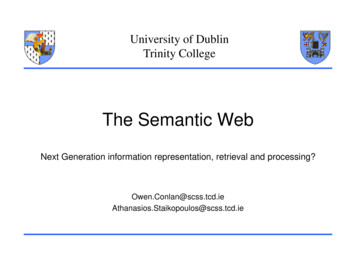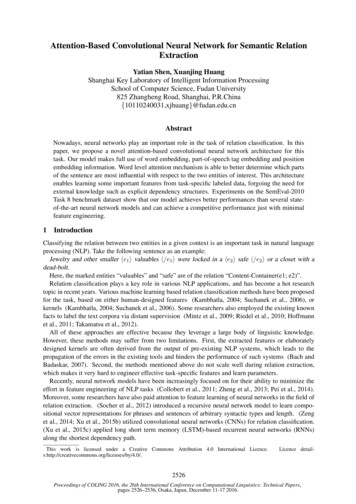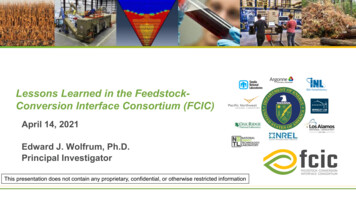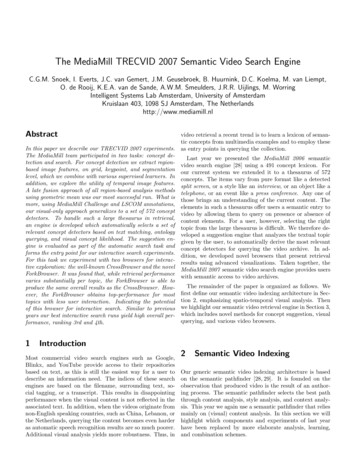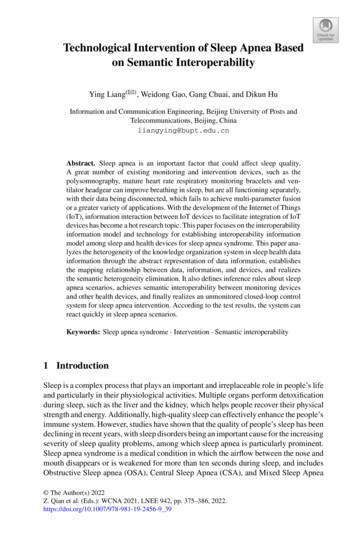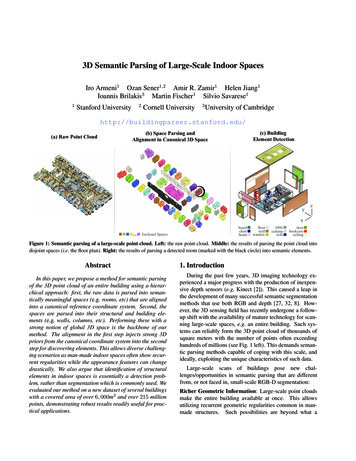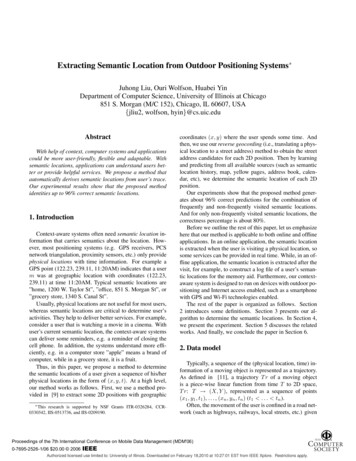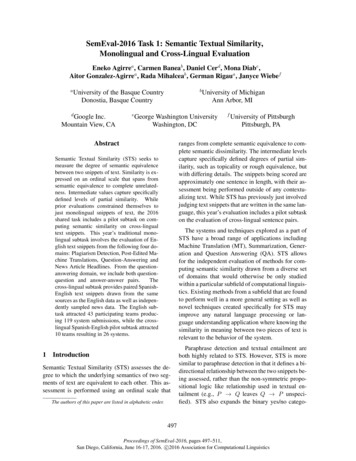
Transcription
SemEval-2016 Task 1: Semantic Textual Similarity,Monolingual and Cross-Lingual EvaluationEneko Agirrea , Carmen Baneab , Daniel Cerd , Mona Diabe ,Aitor Gonzalez-Agirrea , Rada Mihalceab , German Rigaua , Janyce WiebefaUniversity of the Basque CountryDonostia, Basque CountryGoogle Inc.Mountain View, CAdebUniversity of MichiganAnn Arbor, MIGeorge Washington UniversityWashington, DCAbstractfUniversity of PittsburghPittsburgh, PAranges from complete semantic equivalence to complete semantic dissimilarity. The intermediate levelscapture specifically defined degrees of partial similarity, such as topicality or rough equivalence, butwith differing details. The snippets being scored areapproximately one sentence in length, with their assessment being performed outside of any contextualizing text. While STS has previously just involvedjudging text snippets that are written in the same language, this year’s evaluation includes a pilot subtaskon the evaluation of cross-lingual sentence pairs.Semantic Textual Similarity (STS) seeks tomeasure the degree of semantic equivalencebetween two snippets of text. Similarity is expressed on an ordinal scale that spans fromsemantic equivalence to complete unrelatedness. Intermediate values capture specificallydefined levels of partial similarity. Whileprior evaluations constrained themselves tojust monolingual snippets of text, the 2016shared task includes a pilot subtask on computing semantic similarity on cross-lingualtext snippets. This year’s traditional monolingual subtask involves the evaluation of English text snippets from the following four domains: Plagiarism Detection, Post-Edited Machine Translations, Question-Answering andNews Article Headlines. From the questionanswering domain, we include both questionquestion and answer-answer pairs.Thecross-lingual subtask provides paired SpanishEnglish text snippets drawn from the samesources as the English data as well as independently sampled news data. The English subtask attracted 43 participating teams producing 119 system submissions, while the crosslingual Spanish-English pilot subtask attracted10 teams resulting in 26 systems.The systems and techniques explored as a part ofSTS have a broad range of applications includingMachine Translation (MT), Summarization, Generation and Question Answering (QA). STS allowsfor the independent evaluation of methods for computing semantic similarity drawn from a diverse setof domains that would otherwise be only studiedwithin a particular subfield of computational linguistics. Existing methods from a subfield that are foundto perform well in a more general setting as well asnovel techniques created specifically for STS mayimprove any natural language processing or language understanding application where knowing thesimilarity in meaning between two pieces of text isrelevant to the behavior of the system.1 IntroductionSemantic Textual Similarity (STS) assesses the degree to which the underlying semantics of two segments of text are equivalent to each other. This assessment is performed using an ordinal scale thatThe authors of this paper are listed in alphabetic order.Paraphrase detection and textual entailment areboth highly related to STS. However, STS is moresimilar to paraphrase detection in that it defines a bidirectional relationship between the two snippets being assessed, rather than the non-symmetric propositional logic like relationship used in textual entailment (e.g., P Q leaves Q P unspecified). STS also expands the binary yes/no catego-497Proceedings of SemEval-2016, pages 497–511,San Diego, California, June 16-17, 2016. c 2016 Association for Computational Linguistics
Score543210EnglishCross-lingual Spanish-EnglishThe two sentences are completely equivalent, as they mean the same thing.The bird is bathing in the sink.El pájaro se esta bañando en el lavabo.Birdie is washing itself in the water basin.Birdie is washing itself in the water basin.The two sentences are mostly equivalent, but some unimportant details differ.In May 2010, the troops attempted to invade En mayo de 2010, las tropas intentaron invadirKabul.Kabul.The US army invaded Kabul on May 7th last The US army invaded Kabul on May 7th lastyear, 2010.year, 2010.The two sentences are roughly equivalent, but some important information differs/missing.John said he is considered a witness but not a John dijo que él es considerado como testigo, ysuspect.no como sospechoso.“He is not a suspect anymore.” John said.“He is not a suspect anymore.” John said.The two sentences are not equivalent, but share some details.They flew out of the nest in groups.Ellos volaron del nido en grupos.They flew into the nest together.They flew into the nest together.The two sentences are not equivalent, but are on the same topic.The woman is playing the violin.La mujer está tocando el violı́n.The young lady enjoys listening to the guitar. The young lady enjoys listening to the guitar.The two sentences are completely dissimilar.John went horse back riding at dawn with a Al amanecer, Juan se fue a montar a caballo conwhole group of friends.un grupo de amigos.Sunrise at dawn is a magnificent view to take Sunrise at dawn is a magnificent view to take inin if you wake up early enough for it.if you wake up early enough for it.Table 1: Similarity scores with explanations and examples for the English and the cross-lingual Spanish-English subtasks.rization of both paraphrase detection and textual entailment to a finer grained similarity scale. The additional degrees of similarity introduced by STS aredirectly relevant to many applications where intermediate levels of similarity are significant. For example, when evaluating machine translation systemoutput, it is desirable to give credit for partial semantic equivalence to human reference translations.Similarly, a summarization system may prefer shortsegments of text with a rough meaning equivalenceto longer segments with perfect semantic coverage.STS is related to research into machine translation evaluation metrics. This subfield of machinetranslation investigates methods for replicating human judgements regarding the degree to which atranslation generated by an machine translation system corresponds to a reference translation producedby a human translator. STS systems plausibly couldbe used as a drop-in replacement for existing translation evaluation metrics (e.g., BLEU, MEANT, ME-498TEOR, TER).1 The cross-lingual STS subtask thatis newly introduced this year is similarly related tomachine translation quality estimation.The STS shared task has been held annuallysince 2012, providing a venue for the evaluation ofstate-of-the-art algorithms and models (Agirre et al.,2012; Agirre et al., 2013; Agirre et al., 2014; Agirreet al., 2015). During this time, a diverse set of genres and data sources have been explored (i.a., newsheadlines, video and image descriptions, glossesfrom lexical resources including WordNet (Miller,1995; Christiane Fellbaum, 1998), FrameNet (Bakeret al., 1998), OntoNotes (Hovy et al., 2006), webdiscussion forums, and Q&A data sets). This year’s1Both monolingual and cross-lingual STS score what is referred to in the machine translation literature as adequacy andignore fluency unless it obscures meaning. While popular machine translation evaluation techniques do not assess fluency independent from adequacy, it is possible that the deeper semanticassessment being performed by STS systems could benefit frombeing paired with a separate fluency module.
evaluation adds new data sets drawn from plagiarism detection and post-edited machine translations.We also introduce an evaluation set on Q&A forumquestion-question similarity and revisit news headlines and Q&A answer-answer similarity. The 2016task includes both a traditional monolingual subtaskwith English data and a pilot cross-lingual subtaskthat pairs together Spanish and English texts.2Task OverviewSTS presents participating systems with paired textsnippets of approximately one sentence in length.The systems are then asked to return a numericalscore indicating the degree of semantic similaritybetween the two snippets. Canonical STS scoresfall on an ordinal scale with 6 specifically defineddegrees of semantic similarity (see Table 1). Whilethe underlying labels and their interpretation are ordinal, systems can provide real valued scores to indicate their semantic similarity prediction.Participating systems are then evaluated based onthe degree to which their predicted similarity scorescorrelate with STS human judgements. Algorithmsare free to use any scale or range of values for thescores they return. They are not punished for outputting scores outside the range of the interpretablehuman annotated STS labels. This evaluation strategy is motivated by a desire to maximize the flexibility in the design of machine learning models andsystems for STS. It reinforces the assumption thatcomputing textual similarity is an enabling component for other natural language processing applications, rather than being an end in itself.Table 1 illustrates the ordinal similarity scale theshared task uses. Both the English and the crosslingual Spanish-English STS subtasks use a 6 pointsimilarity scale. A similarity label of 0 means thattwo texts are completely dissimilar; this can be interpreted as two sentences with no overlap in theirmeanings. The next level up, a similarity label of1, indicates that the two snippets are not equivalentbut are topically related to each other. A label of2 indicates that the two texts are still not equivalentbut agree on some details of what is being said. Thelabels 3 and 4, both indicate that the two sentencesare approximately equivalent. However, a score of 3implies that there are some differences in important499details, while a score of 4 indicates that the differingdetails are not important. The top score of 5, denotesthat the two texts being evaluated have complete semantic equivalence.In the context of the STS task, meaning equivalence is defined operationally as two snippets oftext that mean the same thing when interpreted by areasonable human judge. The operational approachto sentence level semantics was popularized by therecognizing textual entailment task (Dagan et al.,2010). It has the advantage that it allows the labeling of sentence pairs by human annotators withoutany training in formal semantics, while also beingmore useful and intuitive to work with for downstream systems. Beyond just sentence level semantics, the operationally defined STS labels also reflectboth world knowledge and pragmatic phenomena.As in prior years, 2016 shared task participants are allowed to make use of existing resourcesand tools (e.g., WordNet, Mikolov et al. (2013)’sword2vec). Participants are also allowed to makeunsupervised use of arbitrary data sets, even if suchdata overlaps with the announced sources of theevaluation data.3English SubtaskThe English subtask builds on four prior years of English STS tasks. Task participants are allowed to useall of the trial, train and evaluation sets released during prior years as training and development data. Asshown in table 2, this provides 14,250 paired snippets with gold STS labels. The 2015 STS task annotated between 1,500 and 2,000 pairs per data setthat were then filtered based on annotation agreement and to achieve better data set balance. Theraw annotations were released after the evaluation,providing an additional 5,500 pairs with noisy STSannotations (8,500 total for 2015).2The 2016 English evaluation data is partitionedinto five individual evaluation sets: Headlines, Plagiarism, Postediting, Answer-Answer and QuestionQuestion. Each evaluation set has between 209 to254 pairs. Participants annotate a larger number ofpairs for each dataset without knowledge of whatpairs will be included in the final evaluation.2Answers-forums: 2000; Answers-students: 1500; Belief:2000; Headlines: 1500; Images: 1500.
5249230244254209sourcenewswirevideosglossesWMT eval.WMT eval.newswireglossesglossesMT eval.newswire headlinesglossesforum postsnews summaryimage descriptionstweet-news pairsnewswire headlinesimage descriptionsstudent answersQ&A forum answerscommitted beliefnewswire headlinesshort-answer plag.MT posteditsQ&A forum answersQ&A forum questionsTable 2: English subtask: Train (2012, 2013, 2014, 2015) andtest (2016) data sets.3.1 Data CollectionThe data for the English evaluation sets are collectedfrom a diverse set of sources. Data sources are selected that correspond to potentially useful domainsfor application of the semantic similarity methodsexplored in STS systems. This section details thepair selection heuristics as well as the individual datasources we use for the evaluation sets.3.1.1 Selection HeuristicsUnless otherwise noted, pairs are heuristically selected using a combination of lexical surface formand word embedding similarity between a candidatepair of text snippets. The heuristics are used to findpairs sharing some minimal level of either surfaceor embedding space similarity. An approximatelyequal number of candidate sentence pairs are produced using our lexical surface form and word embedding selection heuristics. Both heuristics makeuse of a Penn Treebank style tokenization of the textprovided by CoreNLP (Manning et al., rcepairs103301294sourceSampled 2015 STSen-es news articlesen news headlines,short-answer plag.,MT postedits,Q&A forum answers,Q&A forum questionsTable 3: Spanish-English subtask: Trial and test data sets.Surface Lexical Similarity Our surface form selection heuristic uses an information theoretic measure based on unigram overlap (Lin, 1998). Asshown in equation (1), surface level lexical similarity between two snippets s1 and s2 is computed asa log probability weighted sum of the words common to both snippets divided by a log probabilityweighted sum of all the words in the two snippets.siml (s1 , s1 ) P2 w s1 s2 log P (w)PPw s1 log P (w) w s2 log P (w)(1)Unigram probabilities are estimated over the evaluation set data sources and are computed withoutany smoothing.Word Embedding Similarity As our secondheuristic, we compute the cosine between a simpleembedding space representation of the two text snippets. Equation (2) illustrates the construction of thesnippet embedding space representation, v(s), asthe sum of the embeddings for the individual words,v(w), in the snippet. The cosine similarity can thenbe computed as in equation (3).v(s) Xv(w)(2)w ssimv (s1 , s2 ) v(s1 )v(s2 ) v(s1 ) v(s2 ) (3)Three hundred dimensional word embeddings areobtained by running the GloVe package (Penningtonet al., 2014) with default parameters over all the datacollected from the 2016 evaluation sources.33The evaluation source data contained only 10,352,554 tokens. This is small relative to the data sets used to train embedding space models that typically make use of 1B tokens.However, the resulting embeddings are found to be functionally
3.1.2 Newswire HeadlinesThe newswire headlines evaluational set is collected from the Europe Media Monitor (EMM) (Bestet al., 2005) using the same extraction approachtaken for STS 2015 (Agirre et al., 2015) over thedate range July 28, 2014 to April 10, 2015. TheEMM clusters identify related news stories. To construct the STS pairs, we extract 749 pairs of headlines that appear in same cluster and 749 pairs ofheadlines associated with stories that appear in different clusters. For both groups, we use a surfacelevel string similarity metric found in the Perl package String::Similarity (Myers, 1986) to select an equal number of pairs with high and low surface similarity scores.3.1.3 PlagiarismThe plagiarism evaluation set is based on Cloughand Stevenson (2011)’s Corpus of Plagiarised ShortAnswers. This corpus provides a collection ofshort answers to computer science questions thatexhibit varying degrees of plagiarism from relatedWikipedia articles.4 The short answers include textthat was constructed by each of the following fourstrategies: 1) copying and pasting individual sentences from Wikipedia; 2) light revision of materialcopied from Wikipedia; 3) heavy revision of material from Wikipedia; 4) non-plagiarised answersproduced without even looking at Wikipedia. Thiscorpus is segmented into individual sentences usingCoreNLP (Manning et al., 2014).3.1.4 PosteditingThe Specia (2011) EAMT 2011 corpus providesmachine translations of French news data using theMoses machine translation system (Koehn et al.,2007) paired with postedited corrections of thosetranslations.5 The corrections were provided by human translators instructed to perform the minimumuseful for finding semantically similar text snippets that differin surface form.4Questions: A. What is inheritance in object orientated programming?, B. Explain the PageRank algorithm that is used bythe Google search engine, C. Explain the Vector Space Modelthat is used for Information Retrieval., D. Explain Bayes Theorem from probability theory, E. What is dynamic programming?5The corpus also includes English news data machine translated into Spanish and the postedited corrections of these translations. We use the English-Spanish data in the cross-lingualtask.501number of changes necessary to produce a publishable translation. STS pairs for this evaluation set areselected both using the surface form and embeddingspace pairing heuristics and by including the existing explicit pairs of each machine translation withits postedited correction.3.1.5 Question-Question & Answer-AnswerThe question-question and answer-answer evaluation sets are extracted from the Stack ExchangeData Dump (Stack Exchange, Inc., 2016). The datainclude long form Question-Answer pairs on a diverse set of topics ranging from highly technical areas such as programming, physics and mathematicsto more casual topics like cooking and travel.Pairs are constructed using questions and answersfrom the following less technical Stack Exchangesites: academia, cooking, coffee, diy, english, fitness, health, history, lifehacks, linguistics, money,movies, music, outdoors, parenting, pets, politics,productivity, sports, travel, workplace and writers.Since both the questions and answers are long form,often being a paragraph in length or longer, heuristics are used to select a one sentence summary ofeach question and answer. For questions, we usethe title of the question when it ends in a questionmark.6 For answers, a one sentence summary ofeach question is constructed using LexRank (Erkanand Radev, 2004) as implemented by the Sumy7package.4Cross-lingual SubtaskThe pilot cross-lingual subtask explores the expansion of STS to paired snippets of text in different languages. The 2016 shared task pairs snippets in Spanish and English, with each pair containing exactlyone Spanish and one English member. A trial set of103 pairs was released prior to the official evaluationwindow containing pairs of sentences randomly selected from prior English STS evaluations, but withone of the snippets being translated into Spanish byhuman translators.8 The similarity scores associatedwith this set are taken from the manual STS annotations within the original English data.6Questions with titles not ending in a “?” are discarded.https://pypi.python.org/pypi/sumy8SDL was used to translate the trial data set, http://sdl.com.7
Figure 1: Annotation instructions for the STS English subtask.Participants are allowed to use the labeled STSpairs from any of the prior STS evaluations. Thisincludes STS pairs from all four prior years of theEnglish STS subtasks as well as data from the 2014and 2015 Spanish STS subtasks.4.1 Data CollectionThe cross-lingual evaluation data is partitioned intotwo evaluation sets: news and multi-source. Thenews data set is manually harvested from multilingual news sources, while the multi-source dataset issampled from the same sources as the 2016 Englishdata, with one of the snippets being translated intoSpanish by human translators.9 As shown in Table3, the news set has 301 pairs, while the multi-sourceset has 294 pairs. For the news evaluation set, participants are provided with exactly the 301 pairs thatwill be used for the final evaluation. For the multisource dataset, we take the same approach as the English subtask and release 2,973 pairs for annotationby participant systems, without providing information on what pairs will be included in the final evaluation.4.1.1 Cross-lingual NewsThe cross-lingual news dataset is manually culledfrom less mainstream news sources such as Russia9The evaluation set was translated into Spanish by Gengo:http://gengo.com/502Today10 , in order to pose a more natural challengein terms of machine translation accuracy. Articleson the same or differing topics are collected, withparticular effort being spent to find articles on thesame or somewhat similar story (many times writtenby the same author in English and Spanish), that exhibit a natural writing pattern in each language by itself and do not amount to an exact translation. Whencompared across the two languages, such articles exhibit different sentence structure and length. Additional paragraphs are also included by the writer thatwould cater to the readers’ interests. For example, inthe case of articles written about the Mexican druglord Joaquin “El Chapo” Guzman, who was recentlycaptured, the English articles typically have less extraneous details, focusing more on facts, while thearticles written in Spanish provide additional background information with more narrative. Such articles allow for the manual extraction of high quality pairs that enable a wider variety of testing scenarios: from exact translations, to paraphrases exhibiting a different sentence structure, to somewhatsimilar sentences, to sentences sharing common vocabulary but no topic similarity, and ultimately tocompletely unrelated sentences. This ensures thatsemantic similarity systems that rely heavily on lexical features (which have been also typically usedin STS tasks to derive test and train datasets) are at10English: https://www.rt.com/, Spanish: https://actualidad.rt.com/
a disadvantage, and rather systems that actually explore semantic information receive due credit.4.1.2 Multi-sourceThe raw multi-source data sets annotated by participating systems are constructed by first sampling250 pairs from each of the following four data setsfrom the English task: Answer-Answer, Plagiarism,Question-Question and Headlines. One sentencefrom each sampled pair is selected at random fortranslation into Spanish by human translators.11 Anadditional 1973 pairs are drawn from the EnglishSpanish section of EAMT 2011. We include all pairings of English source sentences with their humanpost-edited Spanish translations, resulting in 1000pairs. We also include pairings of English sourcesentences with their Spanish machine translations.This only produced an additional 973 pairs, since 27of the pairs are already generated by human postedited translations that exactly match their corresponding machine translations. The gold standarddata are selected by randomly drawing 60 pairs belonging to each data set within the raw multi-sourcedata, except for EMM where only 54 pairs weredrawn.125AnnotationAnnotation of pairs with STS scores is performed using crowdsourcing on Amazon Mechanical Turk.13 This section describes the templates andannotation parameters we use for the English andcross-lingual Spanish-English pairs, as well as howthe gold standard annotations are computed frommultiple annotations from crowd workers.5.1 English SubtaskThe annotation instructions for the English subtaskare modified from prior years in order to accommodate the annotation of question-question pairs. Figure 1 illustrates the new instructions. References tostatements are replaced with snippets. The new instructions remove the wording suggesting that anno11Inspection of the data suggests the translation serviceprovider may have used a postediting based process.12Our annotators work on batches of 7 pairs. Drawing 54pairs from the EMM data results in a total number pairs that iscleanly divisible by 7.13https://www.mturk.com/503tators “picture what is being described” and providetips for navigating the annotation form quickly. Theannotation form itself is also modified from prioryears to make use of radio boxes to annotate the similarity scale rather than drop-down lists.The English STS pairs are annotated in batchesof 20 pairs. For each batch, annotators are paid 1USD. Five annotations are collected per pair. Onlyworkers with the MTurk master qualification are allowed to perform the annotation, a designation bythe MTurk platform that statistical identifies workerswho perform high quality work across a diverse setof MTurk tasks. Gold annotations are selected as themedian value of the crowdsourced annotations afterfiltering out low quality annotators. We remove annotators with correlation scores 0.80 using a simulated gold annotation computed by leaving out theannotations from the worker being evaluated. Wealso exclude all annotators with a kappa score 0.20 against the same simulated gold standard.The official task evaluation data are selected frompairs having at least three remaining labels after excluding the low quality annotators. For each evaluation set, we attempt to select up to 42 pairs foreach STS label. Preference was given to pairs witha higher number of STS labels matching the median label. After the final pairs are selected, theyare spot checked with some of the pairs having theirSTS score corrected.5.2Cross-lingual Spanish-English SubtaskThe Spanish-English pairs are annotated using aslightly modified template from the 2014 and 2015Spanish STS subtask. Given the multilingual natureof the subtask, the guidelines consist of alternatinginstructions in either English or Spanish, in order todissuade monolingual annotators from participating(see Figure 2). The template is also modified to usethe same six point scale used by the English subtask,rather than the five point scale used in the Spanishsubtasks in the past (which did not attempt to distinguish between differences in unimportant details).Judges are also presented with the cross-lingual example pairs and explanations listed on Table 1.The cross-lingual pairs are annotated in batchesof 7 pairs. Annotators are paid 0.30 USD per batchand each batch receives annotations from 5 workers. The annotations are restricted to workers who
Figure 2: Annotation instructions for the STS Spanish-English subtask.have completed 500 HITs on the MTurk platformand have less than 10% of their lifetime annotationsrejected. The gold standard is computed by averaging over the 5 annotations collected for each pair.6System EvaluationThis section reports the evaluation results forthe 2016 STS English and cross-lingual SpanishEnglish subtasks.6.1 ParticipationParticipating teams are allowed to submit up to threesystems.14 For the English subtask, there were 119systems from 43 participating teams. The crosslingual Spanish-English subtask saw 26 submissionsfrom 10 teams. For the English subtask, this is a45% increase in participating teams from 2015. TheSpanish-English STS pilot subtask attracted approximately 53% more participants than the monolingualSpanish subtask organized in 2015.6.2 Evaluation MetricOn each test set, systems are evaluated based ontheir Pearson correlation with the gold standard STSlabels. The overall score for each system is computed as the average of the correlation values on theindividual evaluation sets, weighted by the numberof data points in each evaluation set.6.3 BaselineSimilar to prior years, we include a baseline builtusing a very simple vector space representation. For14For the English subtask, the SimiHawk team was grantedpermission to make 4 submissions as the team has 3 submissions using distinct machine learning models (feature engineered, LSTM, and Tree LSTM) and they asked to separatelysubmit an ensemble of the three methods.504this baseline, both text snippets in a pair are first tokenized by white-space. The snippets are then projected to a one-hot vector representation such thateach dimension corresponds to a word observed inone of the snippets. If a word appears in a snippetone or more times, the corresponding dimension inthe vector is set to one and is otherwise set to zero.The textual similarity score is then computed as thecosine between these vector representations of thetwo snippets.6.4English SubtaskThe rankings for the English STS subtask are givenin Tables 4 and 5. The baseline system ranked 100th.Table 6 provides the best and median scores for eachof the individual evaluation sets as well as overall.15The table also provides the difference between thebest and median scores to highlight the extent towhich top scoring systems outperformed the typicallevel of performance achieved on each data set.The best overall performance is obtained bySamsung Poland NLP Team’s EN1 system, whichachieves an overall correlation of 0.778 (Rychalska et al., 2016). This system also performs beston three out of the five individual evaluation sets:answer-answer, headlines, plagiarism. The EN1 system achieves competitive performance on the postediting data with a correlation score of 0.83516. Thebest system on the postediting data, RICOH’s Run-n(Itoh, 2016), obtains a score of 0.867. Like all systems, EN1 struggles on the question-question data,achieving a correlation of 0.687. Another systemsubmitted by the Samsung Poland NLP Team named15The median sc
Table 1 illustrates the ordinal similarity scale the shared task uses. Both the English and the cross-lingual Spanish-English STS subtasks use a 6 point similarity scale. A similarity label of 0 means that two texts are completely dissimilar; this can be in-terpreted as two sentences with no overlap in their meanings.
